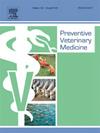丹麦育肥猪中抗菌剂使用水平与肉品检验损伤之间的关系
IF 2.4
2区 农林科学
Q1 VETERINARY SCIENCES
引用次数: 0
摘要
在丹麦,黄牌计划对超过官方允许的抗菌素使用限制(AMU)的猪群实施限制。为了评估黄牌是否与动物健康状况不佳有关,我们使用肉类检查数据作为猪健康的代理,检查了AMU与丹麦育肥猪健康状况之间的关系。我们纳入了2016年至2020年期间交付给9个丹麦屠宰场的1050万只育肥猪的肉类检查结果,这些育肥猪来自被分类为低、中、高AMU(黄牌畜群)的畜群。在混合效应逻辑回归模型中,计算和分析了肉类检查结果的流行程度,以确定八种选定病变与AMU水平之间的关联,同时还考虑了畜群规模、位置(东部或西部)和畜群类型(室内或室外)的影响。尽管在AMU上存在差异,但在肉类检查病变上只有微小的差异。多变量模型的总体结果是,中等AMU水平的畜群与最低的肉类检查病变患病率相关-在调查的8个病变中观察到5个。此外,与小畜群相比,大畜群的肉类检查病变患病率较低-在8个病变中观察到7个。与东部地区相比,丹麦西部地区的牛群肺部和尾部病变的患病率更高,室外牛群的尾部病变、关节炎和骨髓炎的患病率高于室内牛群。因此,较高和较低的人均收入都可能与健康和福利问题有关。结果表明,畜群兽医的咨询作用在防止抗菌素减少措施对动物健康和福利的不利影响方面至关重要,特别是如果黄牌限制进一步减少。本文章由计算机程序翻译,如有差异,请以英文原文为准。
Association between antimicrobial use levels and meat inspection lesions in Danish finishers
In Denmark, the Yellow Card scheme enforces restrictions on pig herds exceeding official permitted limits for antimicrobial use (AMU). To assess if a Yellow Card is related to poor animal health, we examined the association between AMU and the health status of Danish finishers using meat inspection data as a proxy for pig health. We included meat inspection findings in 10.5 million finishers delivered to 9 Danish abattoirs between 2016 and 2020 from herds classified as having a low, medium, or high AMU (Yellow Card herds). The prevalence of meat inspection findings was calculated and analysed in mixed-effects logistic regression models to determine the associations between each of eight selected lesions and AMU level while also considering the effect of herd size, location (east or west) and herd type (indoor or outdoor). Despite differences in AMU, only minor differences in meat inspection lesions were present. The overall result of the multivariable modelling was that herds with a medium AMU level were associated with the lowest prevalence of meat inspection lesions – observed for five out of the eight lesions investigated. Moreover, large herds were associated with a lower prevalence of meat inspection lesions than small herds – observed for seven out of eight lesions. The prevalence of lung and tail lesions was higher for herds in the western region of Denmark compared to the eastern regions, and the prevalence of tail lesions, arthritis and osteomyelitis was higher in outdoor herds compared to indoor herds. Hence, both a high and a low AMU could be linked with health and welfare issues. The results indicate that the advisory role of the herd veterinarian is pivotal in preventing adverse effects of antimicrobial reduction measures on animal health and welfare, in particular, if the Yellow Card limits are reduced further.
求助全文
通过发布文献求助,成功后即可免费获取论文全文。
去求助
来源期刊

Preventive veterinary medicine
农林科学-兽医学
CiteScore
5.60
自引率
7.70%
发文量
184
审稿时长
3 months
期刊介绍:
Preventive Veterinary Medicine is one of the leading international resources for scientific reports on animal health programs and preventive veterinary medicine. The journal follows the guidelines for standardizing and strengthening the reporting of biomedical research which are available from the CONSORT, MOOSE, PRISMA, REFLECT, STARD, and STROBE statements. The journal focuses on:
Epidemiology of health events relevant to domestic and wild animals;
Economic impacts of epidemic and endemic animal and zoonotic diseases;
Latest methods and approaches in veterinary epidemiology;
Disease and infection control or eradication measures;
The "One Health" concept and the relationships between veterinary medicine, human health, animal-production systems, and the environment;
Development of new techniques in surveillance systems and diagnosis;
Evaluation and control of diseases in animal populations.
 求助内容:
求助内容: 应助结果提醒方式:
应助结果提醒方式:


